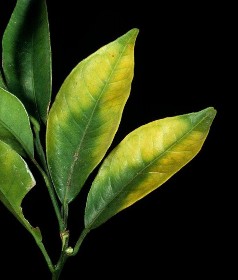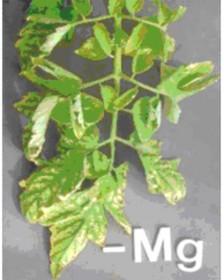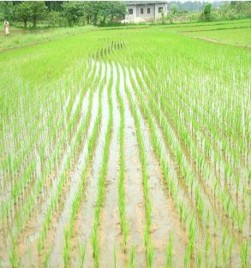4. Symptoms such as leaf yellowing or browning are also nutrient
deficiencies.
5.Nutrient deficiencies affects fruits, leaves and flowers.
6. Nutrient deficiencies may be accompanied by stunted growth and poor flowering or fruiting.
Task 2: Read part 5.1 and answer the following questions.
1/ Why are there deficiency symptoms in the plants growing?
………………………………………………………………………………. 2/ When is the best time for observing visible symptoms?
………………………………………………………………………………. 3/ What can obstruct plants to take up soil nutrients?
………………………………………………………………………………. 4/ How are the nutrient deficiency symptoms of leaves?
………………………………………………………………………………. 5/ Are fruit and vegetables vulnerable if the plants get nutrient deficiency?
……………………………………………………………………………….
2. Nutrient deficiencies
2.1. Nitrogen deficiency

Figure 5.2. Nitrogen deficiency
(Photo: www.haifa-group.com)
Symptoms: Spindly yellow plants or yellow leaves, sometimes with pink tints.
Cause: Nitrogen promotes green, leafy growth and deficiency results in yellowing and stunted growth. Nitrogen is very soluble, so is easily washed out of the soil in winter rains, leaving the soil deficient in spring, just when plants are putting on new growth. Nitrogen deficiency is a common cause of yellow leaves in spring.
Remedy: In the long term, mulching with organic matter (such as well rotted garden compost or manure) provides a steady trickle of nitrogen to stabilise levels. In the short term, applying high nitrogen fertilisers such as sulphate of ammonia or poultry manure pellets will remedy the problem.
2.2. Potassium deficiency

Figure 5.3. Potassium deficiency
(Photo: www.haifa-group.com)
Symptoms: Yellow or purple leaf-tints with browning at the leaf edge and poor flowering or fruiting.
Cause: Potassium is needed for controlling both water uptake and the process allowing plants to harness energy from the sun (photosynthesis). Potassium promotes flowering, fruiting and general hardiness. Shortages
are more likely on light, sandy or chalky soils where potassium is easily washed away. Clay soils, by contrast, hold potassium within their structure.
Remedy: Apply high potassium fertilisers such as sulphate of potash, tomato feed or certain organic potassium sources derived from sugar beet processing.
2.3. Phosphorus deficiency

Figure 5.4. Phosphorus deficiency
(Photo: www.haifa-group.com)
Symptoms: Slow growth and dull yellow foliage.
Cause: Phosphorus is needed for healthy roots and shoot growth. Soil shortages of phosphorus are rare, but may occur in areas with high rainfall and heavy clay soil.
Remedy: Apply fertilisers such as superphosphate or bone meal.
2.4. Magnesium deficiency


Figure 5.5. Magnesium deficiency on orange leaves and tomato leaves
(Photo: Internet source)
Symptoms: Yellowing between the leaf veins, sometimes with reddish brown tints and early leaf fall. Magnesium deficiency is common in tomatoes, apples, grape vines, raspberries, roses and rhododendrons.
Cause: Magnesium is needed for healthy leaves and for plants to harness energy from the sun (photosynthesis). Soil shortages of magnesium are more common on light, sandy soils. Over-use of high-potassium fertilisers (such as tomato feed) can cause magnesium deficiency, as plants take up potassium in preference to magnesium.
Remedy: In the short term, apply Epsom salts as a foliar feed in summer. Dilute the salts at a rate of 20g of Epsom salts per litre of water (1/3oz per pint) plus a few drops of liquid detergent. Apply two or three times at fortnightly intervals, spraying in dull weather to avoid leaf scorch. In the long term apply to the soil around the roots either Dolomite limestone (calcium-magnesium carbonate) at 100g per sq m (4oz per sq yd) or Epsom salts (magnesium sulphate) at 30g per sq m (1oz per sq yd). Dolomite limestone will make the soil more alkaline, so should not be used around
ericaceous (acid-loving) plants such as rhododendrons or camellias, or where the soil is already alkaline.
2.5. Manganese and iron deficiencies


Figure 5.6. Manganese and Iron deficiency
(Photo: www.haifa-group.com)
Symptoms: Yellowing between the leaf veins with browning of leaf edges on acid-loving plants.
Cause: Manganese and iron are important for allowing plants to harness the energy of the sun (photosynthesis). Soil shortages are rare, but manganese and iron can be unavailable to plant roots in alkaline conditions. Ericaceous (acid-loving) plants are particularly vulnerable when growing in alkaline soils or potting composts.
Remedy: Apply chelated iron and manganese treatments, such as Sequestrene, to the soil around the plant roots.
Exercises:
Task 1: Refer part 5.2 and complete the table below.
Symptoms: Parts of tree + Colors | Remedy |
Có thể bạn quan tâm!
-
 Giáo trình Anh văn chuyên ngành bảo vệ thực vật Nghề Bảo vệ thực vật - Cao đẳng - Trường Cao đẳng Cộng đồng Đồng Tháp - 4
Giáo trình Anh văn chuyên ngành bảo vệ thực vật Nghề Bảo vệ thực vật - Cao đẳng - Trường Cao đẳng Cộng đồng Đồng Tháp - 4 -
 Giáo trình Anh văn chuyên ngành bảo vệ thực vật Nghề Bảo vệ thực vật - Cao đẳng - Trường Cao đẳng Cộng đồng Đồng Tháp - 5
Giáo trình Anh văn chuyên ngành bảo vệ thực vật Nghề Bảo vệ thực vật - Cao đẳng - Trường Cao đẳng Cộng đồng Đồng Tháp - 5 -
 Giáo trình Anh văn chuyên ngành bảo vệ thực vật Nghề Bảo vệ thực vật - Cao đẳng - Trường Cao đẳng Cộng đồng Đồng Tháp - 6
Giáo trình Anh văn chuyên ngành bảo vệ thực vật Nghề Bảo vệ thực vật - Cao đẳng - Trường Cao đẳng Cộng đồng Đồng Tháp - 6 -
 Giáo trình Anh văn chuyên ngành bảo vệ thực vật Nghề Bảo vệ thực vật - Cao đẳng - Trường Cao đẳng Cộng đồng Đồng Tháp - 8
Giáo trình Anh văn chuyên ngành bảo vệ thực vật Nghề Bảo vệ thực vật - Cao đẳng - Trường Cao đẳng Cộng đồng Đồng Tháp - 8 -
 Giáo trình Anh văn chuyên ngành bảo vệ thực vật Nghề Bảo vệ thực vật - Cao đẳng - Trường Cao đẳng Cộng đồng Đồng Tháp - 9
Giáo trình Anh văn chuyên ngành bảo vệ thực vật Nghề Bảo vệ thực vật - Cao đẳng - Trường Cao đẳng Cộng đồng Đồng Tháp - 9 -
 Giáo trình Anh văn chuyên ngành bảo vệ thực vật Nghề Bảo vệ thực vật - Cao đẳng - Trường Cao đẳng Cộng đồng Đồng Tháp - 10
Giáo trình Anh văn chuyên ngành bảo vệ thực vật Nghề Bảo vệ thực vật - Cao đẳng - Trường Cao đẳng Cộng đồng Đồng Tháp - 10
Xem toàn bộ 90 trang tài liệu này.
Potassium | ||
Phosphorus | ||
Magnesium | ||
Manganese + Iron |
Task 2: Read part 5.2 and match the statements with the corresponding nutrient deficiencies.
Nitrogen (N) Potassium (P) Phosphorus (P) Magnesium (Mg) Manganese and Iron (Mn + Fe)
1.Soil shortages are more common on light, sandy soils.
2.They can be unavailable to plant roots in alkaline conditions.
3.It promotes flowering, fruiting and general hardiness.
4.Slow growth and dull yellow foliage.
5.Soil shortages are rare, but may occur in areas with high rainfall
and heavy clay soil.
6.It promotes green, leafy growth and deficiency results in
yellowing and stunted growth.
7.Spindly yellow plants or yellow leaves, sometimes with pink tints.
8.Yellowing between the leaf veins with browning of leaf edges on
acid-loving plants.
9.Yellow or purple leaf-tints with browning at the leaf edge and
poor flowering or fruiting.
10. Yellowing between the leaf veins, sometimes with reddish brown tints and early leaf fall.
Further reading 1
TRANSPLANTING PADDY PLANTS
I. Transplanting method helping increase paddy yields

Figure 1. Transplanted paddy plants
(Photo: Internet source)
There are two methods that can be employed by farmers who wish to have higher volume and quality yield in their paddy plantations. One is manual transplantation and the other is the use of machines. Both methods allow sufficient control of space between each paddy plant, enabling the absorption of nutrients and spread of the paddy leaves to maximize the efficiency of photosynthesis.
Properly spaced and well managed plants can reduce weed infestation and the formation of weedy paddy. This helps to reduce the need for pesticides, and reduce the lodging incidences of the paddy due to wind or rain. There will also be a uniform growth of the paddy plants, which will be favorable for any field work. There are valid records showing the efficiency of transplanting with machines. The highest nett yield was obtained in Sekinchan, with a result of about 10 mt/ha. Kerian followed the example of Sekinchan, yielding between 8 to 10 tonnes of paddy per hectare. The use of machine transplanting method have also helped farmers earn a higher yield compared to other methods in the past.






